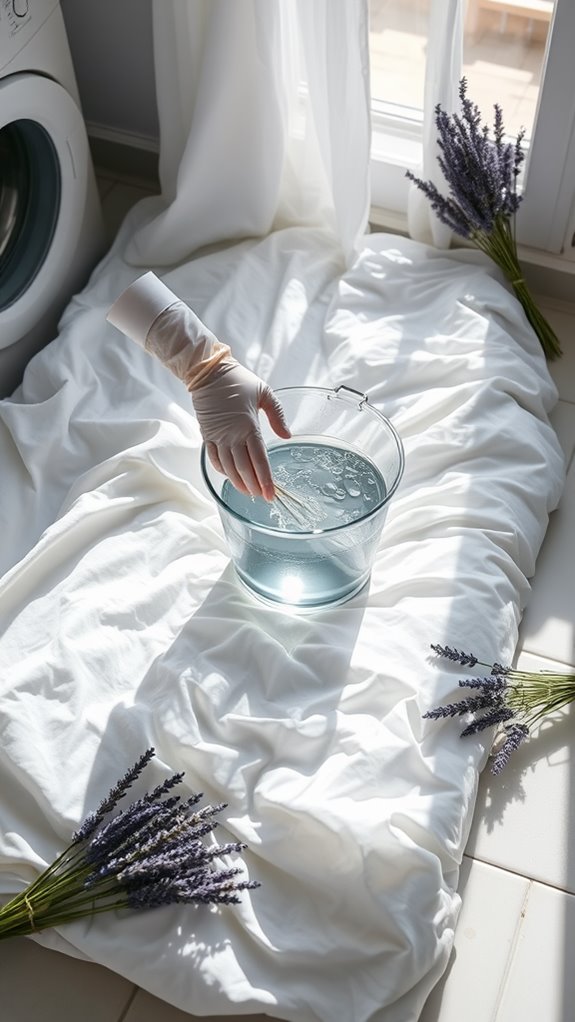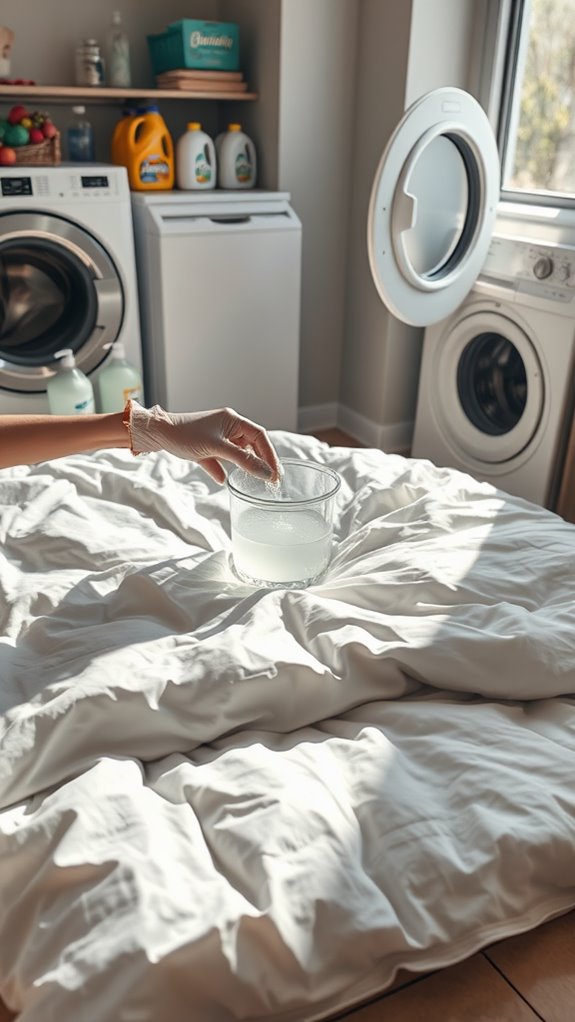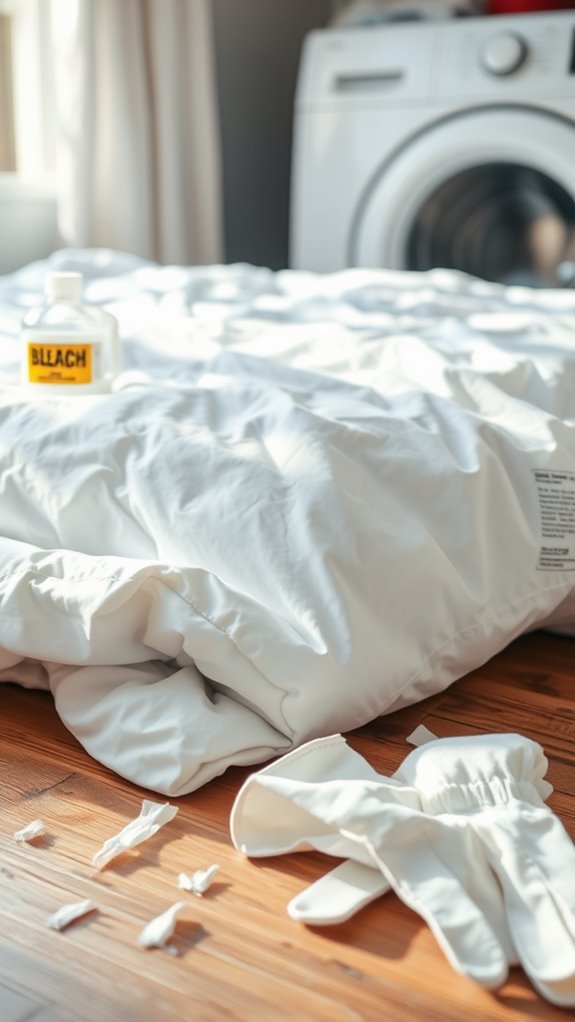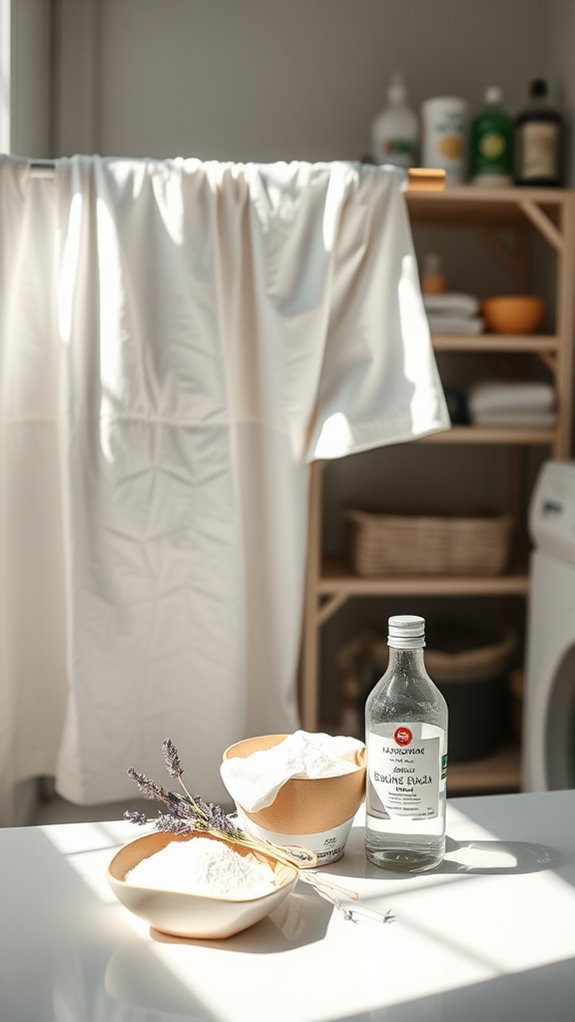How to Bleach a Duvet: a Step-by-step Guide
One sunny Saturday morning, as I sipped my coffee and admired the cozy ambiance of my bedroom, I noticed my beloved duvet had lost its luster. Once a pristine white, it now bore the marks of everyday life—coffee spills and ink smudges from late-night journaling sessions. Determined to restore its former glory, I began wondering how to bleach a duvet without causing damage.
A friend had once mentioned the wonders of bleaching, but with little knowledge about the process, I was unsure if my duvet could withstand such a treatment. After some research and a bit of trial and error, I unearthed the secrets to successfully bleaching a duvet. Let me share my journey and the insights I gained so you can avoid common mistakes and achieve the bright, clean duvet of your dreams.
Can You Bleach a Duvet?

Can you really bleach a duvet? Absolutely, but only if it’s a white comforter made of cotton or a polyester-cotton blend.
Think of it as a hair makeover for your bedding! Just steer clear of silk, wool, or down-filled duvets to avoid a fabric disaster.
Don’t forget to check the care label and do a patch test—your duvet deserves a little TLC! Additionally, using oxygen-based bleach is a gentler alternative to chlorine bleach that can help maintain the integrity of your fabric.
How to Bleach a Duvet?

Alright, let’s get that duvet looking fresh!
First things first, I always check the care label to make sure my duvet can handle a bleach bath—no one wants to ruin their cozy comforter.
Once I’ve confirmed it’s bleach-safe, I pre-treat any pesky stains before whipping up a bleach solution that’ll have my duvet sparkling like new.
Step 1: Check the Care Label
Before you start bleaching your duvet, always check the care label. It contains essential information about the fabric type and washing instructions.
Look for notes on bleach safety—white cotton and polyester blends usually handle bleach well, but down, silk, and wool do not.
Also, verify if machine washing is permitted or if dry cleaning is recommended. This step guarantees you avoid any damage or discoloration. Additionally, it is important to consider different types of bleach to ensure you are using the safest option for your duvet.
Step 2: Pre-Treat Stains
Before you bleach your duvet, check for stains.
For small spots, apply stain remover directly and let it sit for 5–10 minutes.
For larger stains, dilute the remover with water and apply it thoroughly.
Always test the remover on a hidden area first.
To boost bleaching, spot-treat with a mix of gentle detergent and water before washing.
This guarantees the best whitening results! Regular cleaning prevents buildup of allergens and ensures your duvet remains fresh and hygienic.
Step 3: Prepare the Bleach Solution
To prepare your bleach solution, mix 1 cup of bleach with 1 gallon of cool to warm water in a large bucket or basin.
Always wear protective gloves and work in a well-ventilated area.
Dissolve the bleach completely before soaking your duvet, and test the solution on a small hidden area first to guarantee it won’t damage the fabric.
Step 4: Soak the Duvet
To soak your duvet, fill a large bucket or tub with cool to warm water and mix in 1 cup of diluted bleach per gallon of water.
Submerge the duvet completely, ensuring it’s fully saturated. Let it soak for 15-30 minutes, keeping an eye on the fabric to prevent damage.
After soaking, rinse thoroughly with cool water to eliminate any bleach residues.
Step 5: Rinse Thoroughly
After bleaching your duvet, rinse it thoroughly in cool water to remove all bleach residue, as leftover bleach can weaken the fabric.
Use a large-capacity washing machine to avoid overcrowding, and consider running an extra rinse cycle to guarantee complete removal. Additionally, ensure you use a mild detergent to preserve the delicate fibers of the duvet.
Always check the care label for specific instructions, and gently squeeze out excess water without wringing to keep the duvet’s shape intact.
Step 6: Wash the Duvet as Usual
To wash the duvet, place it in the washing machine without overloading.
Use a gentle cycle with cold to warm water (75-85°F). Add the diluted bleach solution as per the instructions, usually 1 cup of bleach per gallon of water. Ensure that the duvet fits well in the washing machine to prevent overcrowding during the wash cycle.
After washing, consider running an extra rinse cycle to eliminate any bleach residue.
Finally, dry the duvet in a large-capacity dryer on medium heat with dryer balls for fluffiness.
Step 7: Air Dry or Use a Dryer on Low Heat
After bleaching your duvet, you can air dry it outdoors for a fresh scent and energy savings.
If you prefer using a dryer, set it to low heat to avoid fabric damage and guarantee even drying. Toss in dryer balls or clean tennis balls to keep the duvet fluffy and prevent clumping.
Check on it regularly, and make certain it’s completely dry before storing to prevent mold and mildew.
Common Mistakes to Avoid When Bleaching a Duvet

While bleaching a duvet can refresh its appearance, several common mistakes can lead to damage or disappointing results.
I’ve learned the hard way not to skip checking the care label—silk and down-filled duvets don’t play nice with bleach!
Also, please, don’t mix bleach with other cleaners in your washing machine; it’s a recipe for disaster and dangerous fumes!
Alternatives to Bleaching Duvets

If you’re looking for ways to refresh your duvet without resorting to harsh bleach, you’re in luck—there are plenty of effective alternatives.
Here are three I love:
- Oxygen bleach: It brightens without the harshness.
- White vinegar: This powerhouse lifts stains and softens fabrics.
- Baking soda: A natural deodorizer that enhances brightness.
Give these a try, and your duvet will thank you!
Frequently Asked Questions
How Do I Get My Duvet White Again?
To get my duvet white again, I check the care label first. Then, I pre-soak it with oxygen bleach, wash it properly, rinse thoroughly, and let it sunbathe for that extra brightness!
Can You Use Bleach on a Duvet?
I wouldn’t recommend using bleach on a duvet without checking the care label first. If it’s safe, I always dilute it properly and test a small area to avoid any unwanted discoloration or damage.
How Do You Get Yellow Stains Out of a Duvet?
I tackle yellow stains on my duvet by pre-treating with dish soap and baking soda. If necessary, I use a diluted bleach solution, but I always check the care label first to avoid damage.
Can You Bleach a Polyester Duvet?
I’ve found that you can bleach a polyester duvet, but it’s essential to check the care label first. Always dilute the bleach and test a small area to avoid any unexpected damage.
In Conclusion
To achieve a fresh and bright duvet, bleach can be a helpful tool if the materials are suitable. Begin by treating any stains, then carefully mix your bleach solution. Keep a close watch on your duvet during the soaking process. With a bit of attention, you can revitalize your bedding. Embrace your laundry skills and let your duvet shine brilliantly. Sweet dreams are just a step away!
